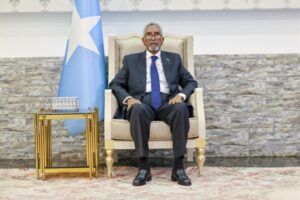
President Joe Biden pledged to end the “forever wars” in the Middle East. He withdrew US forces from Afghanistan last year and has announced that the United States is no longer at war. As he wrote in advance of his trip this week to Israel and Saudi Arabia, “I will be the first president to visit the Middle East since 9/11 without U.S. troops engaged in a combat mission there.”
But the rhetorical contortion of no “U.S. troops engaged in a combat mission” is a little different from being able to simply say that there is no American military presence. That’s because the US still has troops in Iraq and in Syria. In Jordan, Saudi Arabia, Turkey, and Yemen, the US military is, among other things, advising on counterterrorism, and the Pentagon keeps more than 700 personnel in Niger and thousands in Djibouti. The US also deploys drone strikes and special operations forces against targets across the Middle East and Africa without much accountability or oversight.
And in May 2022, Biden agreed to send about 500 US troops to Somalia.
Those troops will return to Somalia soon to fight the extremist group al-Shabaab as the resurrected government of Hassan Sheikh Mohamud (HSM) deepens ties to Washington and seeks the support and legitimacy provided by the American military. But on a deeper level, this US deployment represents the continuity of the so-called war on terrorism in spite of Biden’s best efforts to end it.
Congress has not approved a new resolution for the use of military force abroad, and the Biden administration says it is sending troops to Somalia under the 2001 authorization that Congress passed after the September 11, 2001, attacks to target al-Qaeda — and that has been used in 85 countries as the basis for military activities.
“With Vice-President Biden’s election win, there is a real opportunity to re-imagine U.S. policy toward Africa,” Judd Devermont, a prominent Africa expert in Washington, said in 2020. Now, Devermont is the White House’s top Africa adviser, and there are fears that the US is continuing an old approach that over-emphasizes security policies and doesn’t meet the political moment in Somalia, Africa, or the Middle East.
“This was an opportunity in which the administration could have reset its security relationship with the federal government of Somalia,” Jason Hartwig, a former Army officer who served in the US embassy in Somalia from 2016 to 2018, told me. “We’re just gonna go back to what we were doing, literally, at the end of the last HSM regime, which is incredibly frustrating and disappointing.”
Why is the US in Somalia?
The US has been involved in Somalia for decades. It’s there now because the Biden administration says the Somalia-based extremist group al-Shabaab poses a threat to the US homeland. Al-Shabaab has continued to attack the African Union’s forces and use tactics of terror as part of what the International Crisis Group describes as “an endless cycle of war.” But security experts dispute the extent of the threat to Americans.
“The threat to the homeland is extremely attenuated and possibly nonexistent,” Katherine Ebright of the Brennan Center for Justice told me.
That hasn’t stopped US administrations from engaging militarily there. Troops have been in Somalia since around 2007. The Trump administration increased airstrikes in Somalia to an average of almost 50 per year, and changed a requirement established under President Barack Obama so that the Pentagon could pursue strikes without getting the president’s personal sign-off each time. In 2020, Trump withdrew most (but not all) of the more than 700 US forces in the country.
Biden has now reversed that, approving the troop transfer at Secretary of Defense Lloyd Austin’s request, and they’ll “train, advise, and assist regional forces, including Somali and African Union Mission in Somalia forces, during counterterrorism operations” and conduct “a small number of airstrikes against al-Shabaab,” according to a letter Biden is mandated to send annually to Congress.
Lt. Cmdr. Timothy Pietrack, spokesperson for US African Command, said in a statement that the military is “in the planning stages to return a small persistent US military presence to Somalia” and declined to provide more details.
This is easier and safer, the White House says, than flying back and forth to Somalia from Kenya and Djibouti to carry out operations, which the US had been doing after Trump withdrew most of the forces. “The decision to reintroduce a small but persistent presence was made, first and foremost, to maximize the safety and effectiveness of our force and enable them to provide better support of our partners,” White House spokesperson Karine Jean-Pierre said. (Which presupposes that US troops should be in East Africa in the first place.)
Above all, the White House emphasizes that US forces are in Somalia because the Somalis want the US to be there. When Hassan Sheikh Mohamud was elected as Somalia’s president in May 2022, the US immediately announced that it was sending troops there. The timing suggested that this plan was long in the works, and that the US wants to support his government.
:no_upscale()/cdn.vox-cdn.com/uploads/chorus_asset/file/23762469/GettyImages_1240852958.jpg)
For the Biden administration, success would mean keeping al-Shabaab’s threat within Somalia’s borders. “Simultaneously, we are working toward continued progress on the political side, where we start seeing greater cooperation, less corruption, an effort toward more inclusive politics,” a senior administration official, speaking on the condition of anonymity, told me. “We’re listening to Hassan Sheikh’s agenda and having a conversation with him, and with other Somali actors, about how do they best bring stability to the country.”
Pushing toward political reconciliation will be difficult, as many Somalis see the government as corrupt; they “seek justice and an equitable way of resolving these things,” Samira Gaid, the director of the Hiraal Institute in Mogadishu, told me. “That’s what’s absent. And that’s what al-Shabaab offers.”
By putting US troops in Somalia, the US is back to where it was under Trump and Obama, according to analyst Abukar Arman. “I don’t think it is a good idea if the Biden administration’s objective is to pursue that same failed counterterrorism policy,” the former Somali diplomat wrote by email. “Somalis — save the political elite — consider the return of American troops and Biden’s policy toward Somalia business as usual: more drone strikes, more provocation of al-Shabaab, and more recruitment for the latter.”
Altogether, there have been 268 drone strikes on Somalia over the past two decades, killing up to 120 civilians, according to the think tank New America. Trump presided over 202 of those strikes in Somalia, and even though Biden has markedly decreased them, drone strikes continue. Gathering this data is a challenge, especially because of the risky security situation in Somalia, and the number of victims may be significantly higher.
Research and reporting suggest that such strikes cause blowback. “It’s difficult to argue that they have been effective in keeping America safe,” Priyanka Motaparthy, who directs a project on human rights and armed conflict at Columbia Law School, told me.
What’s the legal justification for US troops in Somalia?
Congress passed the 2001 Authorization of the Use of Military Force (AUMF) to combat al-Qaeda in the aftermath of the 9/11 attacks — the longest-running AUMF in US history.
And it is the legal justification for US involvement in Somalia. “The 2001 AUMF provides sufficient authority to use military force against certain organizations,” another senior Biden administration official wrote in an email statement.
Al-Shabaab has been affiliated with al-Qaeda since 2012, but it’s better understood as a domestic political movement that grew out of the Somali Council of Islamic Courts. Legal experts I spoke with think the ties to al-Qaeda are flimsy because of al-Shabaab’s local roots. One expert described the way al-Shabaab operates as analogous to a junior varsity version of the Taliban: Al-Shabaab operates courts and social services, and it collects taxes.
The legality of the AUMF is also tenuous. The idea of applying it to al-Qaeda’s associated forces — though no such wording is included in the authorization itself — was advanced by former George W. Bush administration official Jack Goldsmith, who testified to Congress last year that it’s not entirely clear which groups can be considered affiliated with al-Qaeda and suggested reforms to the AUMF that “specify the enemy.”
Now, Biden is following in Obama’s path. “The Obama administration determined and notified Congress in 2016 that al-Shabaab is covered by the 2001 AUMF as an associated force of al-Qa’ida,” according to the senior Biden official’s email. “Direct counterterrorism action in Somalia under the current administration is proceeding under a more rigorous approach established by this administration,” the official continued, but did not go into further detail about how Biden’s rules differ from Trump’s.
Major al-Shabaab attacks on US targets, like the 2020 siege on US forces at an airbase in Manda Bay, Kenya, where three Americans died, relate to the US presence there. “I don’t think that there’s a real threat to US territory, to US persons, US property,” Ebright said; the threat is “only really to US forces who are out there already pursuing al-Shabaab.”
:no_upscale()/cdn.vox-cdn.com/uploads/chorus_asset/file/23762481/GettyImages_1238524514.jpg)
And if it’s so important that US forces are there, why not get the buy-in of Congress? “We shouldn’t be actively involved in the war in Somalia without some form of authorization saying why we’re there, who our enemy is, and what we’re allowed to do,” said Elizabeth Shackelford, a former diplomat now at the Chicago Council on Global Affairs. “That should be basic, but nobody cares.”
It’s part of a theme I picked up on in conversations with former and current officials about US policy toward Somalia: There just isn’t that much attention from policymakers given to this country, even though US troops sent there may be in harm’s way.
Can the US go beyond a militarized approach to Somalia?
The government of Hassan Sheikh Mohamud was in office from 2012 to 2017, and its return presents the opportunity of creating political reconciliation in a country that is fractured, divided along federated states and by clans and tribes.
Hassan Sheikh’s government gains legitimacy from the US troop presence, according to Gaid. But she is concerned that the US’s top priority has been the war on terrorism in Somalia, outweighing other goals. “It’s more military-centric, and it should really be people-centric, it should look at reconciliation, at peace-building and all these other aspects,” she told me.
The US does do more than security there. It’s also the largest humanitarian donor to Somalia and is advancing food security initiatives amid a massive famine, given the unprecedented drought there, compounded by the Ukraine grain crisis. Senior State Department official Victoria Nuland traveled last month to Somalia and met President Hassan Sheikh “to offer U.S. support for his security, reconciliation, and reform agenda.”
But for broader political and development policies to succeed, the main priority needs to be addressing al-Shabaab’s deadly 15-year-long insurgency. Everyone knows that insurgencies end with political dialogue, not more military strikes.
In a recent interview, Hassan Sheikh said that ultimately Somalia will need to negotiate with al-Shabaab. Arman, the former Somali diplomat, told me he has been advocating for negotiations with al-Shabaab for over a decade and that subsequent Somali leaders have missed the opportunity to leverage talks.
“There’s no purely military solution,” a State Department official, speaking on the condition of anonymity, told me. “It’s really political factors that are driving this, and the governance challenges that are at the root of this. I don’t think it’s for us to decide whether the Somalis should negotiate with al-Shabaab. That’s a decision that they need to make.”
Though right now might not be the optimal moment to craft a deal with al-Shabaab, it can take years of table-setting to make such complex talks happen. “You want to have the mechanisms for talks in place when the timing is right,” Tricia Bacon, an American University professor and former State Department official, told me. “One of the mistakes of US-Taliban negotiations is that we negotiated when we were ready to leave.”
In the meantime, the US priority appears to be security in the strictest sense, as troops deploy there. Former US ambassador to Somalia Donald Yamamoto reflected in a recent interview on the fact that his two children serve in the US military. “I am not going to have them be deployed to Somalia to fight your wars,” he recalled telling the Somali president when he was ambassador about five years ago. “You have to fight this war yourself.”





